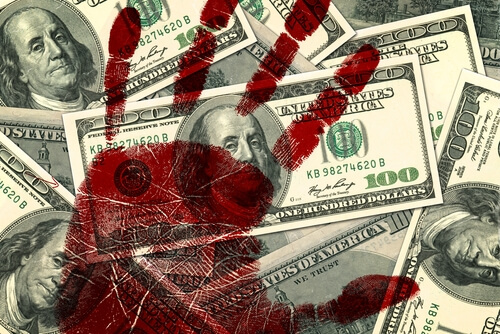Boeing’s 737 Max issues highlighted the company’s sacrifice of safety for financial performance, resulting in a tarnished reputation. The prioritization of profit over core values also damaged the FAA’s credibility and revealed a lack of accountability for top executives. This downfall serves as a reminder of the importance of maintaining core values and prioritizing them over short-term financial gains.

Profit and Revenue are Lousy Core Values
As I mentioned last week, I am down with COVID and tired, so spending more time reading rather than working. I read Bill Browder’s Freezing Order this weekend, and I highly recommend it. However, at the end of the book, Browder says that oligarchs, autocrats, and leaders like Mohammed bin Salman are enabled by the professional service providers that help them. As I reflected on this and Browder’s allegations in his book against John Moscow et al., I had to think, why do these lawyers, bankers, accountants, etc., work for these characters? They know the abuses that their clients commit but are willing to overlook them because their clients pay enormous sums. We saw what Paul Manafort earned helping Russia in Ukraine and Jared Kushner’s recent investment from MBS, so money is the driver. However, money is a lousy core value.
Now don’t get me wrong, I would like to earn a lot of money, but I am not willing to sacrifice my core values. If money, or some proxy like revenue or profit, is your core value, you can have no other core values. Money as the core value overrides any additional core values you may claim and justifies any behavior because the behavior is driving money.
Issues with Money as a Value
So if money is the core value, then the firm attracts those who believe in money as a core value; however, that can cause other issues. For example:
- Loyalty to the firm. If money is the core value, there is no loyalty to the firm as they will move for more money as that is their value. Also, they will do things that can hurt the firm if it brings in more revenue. Here are some examples: Arthur Andersen and Enron, Perdue Pharma and the opioid crises, Boeing 737 Max, and McKinsey’s recent scandals.
- Loyalty to clients. Again there can be no objection to doing something that harms a client if it makes the firm more money as that is the driver. Bill Browder’s book gave a classic example of this with the behavior of John Moscow and Baker & Hostetler. If my research backs up Browder’s claims, I would never recommend Baker & Hostetler to anyone I know and any attorney there is a damaged product in my book.
- Loyalty to colleagues. There is none because making money is all-important, so why sacrifice money to help a colleague?
Now, the scandals above made many a lot of money. If money is your driver, then great. But your legacy is what you did for others, and that is how you are remembered once you’re dead. I would not want people to say, “He was responsible for the death and damage of many.” If that is how you are remembered, many will revile you in time, and your family may start to distance themselves from you. I ran into a high school friend several years ago and mentioned I had met her father after his release from prison. She was so embarrassed she walked away and never spoke to me again. So sad.
As I reflect on all the people I have met in my career, I would say that lawyers are the most unhappy and wish to be doing something else. Now that is not all lawyers, just more lawyers than others. I think that is because many law firms have no culture and will act for any paying client. If your client is against your values, you have sacrificed them for money, which leads to unhappiness because, as we have all heard, “Money doesn’t buy happiness.”
Many of the people involved in the above are on the redemption trail, e.g., Andy Fastow from Enron. But, when you look at him speaking and think of how many people’s lives he knowingly damaged, I have to ask, does going on the speaking circuit redeem him? To me, No.
Culture is Critical.
As discussed earlier, Boeing sacrificed decades of industry safety leadership for profit. The Tory party, today, is sacrificing all its value for power. Once you go down that road, your reputation takes a very long time to return and often more than a lifetime. So it is critical to define your core values. I recommend that you determine your core values and define the expected corporate behaviors that your values prescribe. Then stick to them above all else. As Jim Collins said, “You would sacrifice profit rather than your core values.” Also, when hiring, look at where a candidate has come from, and that firm reflects your core values. It is easier to teach a skill than new values.
As you reflect on decisions, always think of your “elder” self looking back at the end of life and ask, is that how I want to be remembered?
(c) Copyright 2022, Marc A. Borrelli
Recent Posts
The Downfall of Boeing: A Lesson in Core Values
Resolutions, Here We Go Again.
In reflecting on 2021 resolutions, the author scored themselves in three categories and sought to improve success in 2022 by addressing friction points. Drawing on advice from social psychologist Wendy Wood, the author identified areas to reduce or increase friction in their failed resolutions. By making these adjustments, the author aims to enhance their goal achievement and encourages others to consider friction when setting resolutions.
You need to take an extended vacation. No, seriously, you do.
COVID has taken a toll on all of us. If you have not taken an extended vacation in a while where you disconnect, you need to now. You and your business will benefit.
Becoming Famous in Your Niche: The Success Story of Linn Products Limited
In a previous discussion, I highlighted the importance of being famous for something. Being well-known in your niche can help you: Concentrate on your strengths Connect with your target audience Communicate your offerings more effectively Receive referrals Identify...
Understanding and Optimizing Your Cash Conversion Cycle
Understanding and optimizing the Cash Conversion Cycle is crucial for business growth, as it impacts cash flow and the ability to access external capital. This cycle consists of four components: Sales, Make/Production & Inventory, Delivery, and Billing and Payments. To improve the Cash Conversion Cycle, companies can eliminate mistakes, shorten cycle times, and revamp their business models.
Discovering Your Niche: Why You Need to Be Famous for Something
As an entrepreneur, it’s crucial to specialize in a specific area and become famous for something, allowing you to generate referrals and build your brand. Understanding the “job” you’re hired for helps you stand out in the marketplace and communicate your value proposition effectively. By providing value to your clients, you can adopt a value-based pricing approach, ensuring your business remains competitive and maintains a strong market presence.
Rethinking Your Pricing Model: Maximizing Margins and Providing Value
Rethink your pricing model by focusing on the value you provide and your customers’ Best Alternative To a Negotiated Agreement (BATNA). This approach can help you maximize margins while delivering better value to your clients. Assess your offerings and brainstorm with your team to identify pricing adjustment opportunities or eliminate commodity products or services.
Do you know your Profit per X to drive dramatic growth?
I recently facilitated a workshop with several CEOs where we worked on the dramatic business growth model components. One of the questions that I had asked them beforehand was, "What is Your Profit/X?" The results showed that there this concept is not clear to many....
The War for Talent: 5 Ways to Attract the Best Employees
In today’s War for Talent, attracting the best employees requires a focus on value creation, core customer, brand promise, and value delivery. Clearly articulate your company’s mission, identify your “core employee” based on shared values, and offer more than just a salary to stand out as an employer. Utilize employee satisfaction metrics and showcase your company’s commitment to its workforce on your website to make a strong impression on potential candidates.
Are you killing your firm’s WFH productivity?
Productivity remained during WFH with COVID. However, further analysis found that hourly productivity fell and was compensated for by employees working more hours. What was the culprit – Meetings. Want to increase productivity, have fewer meetings.














